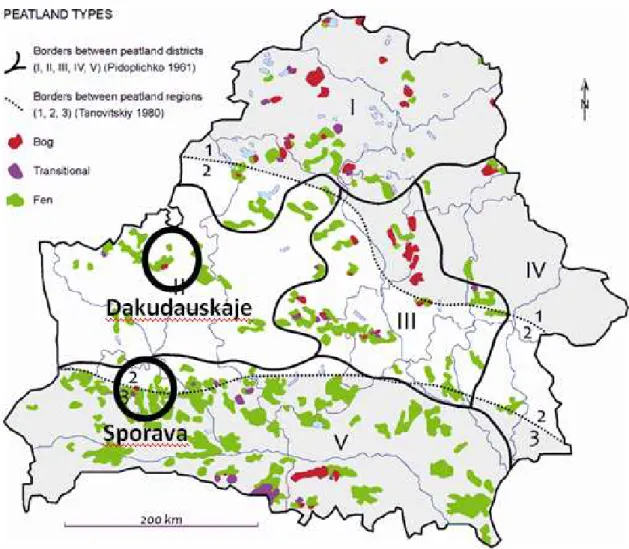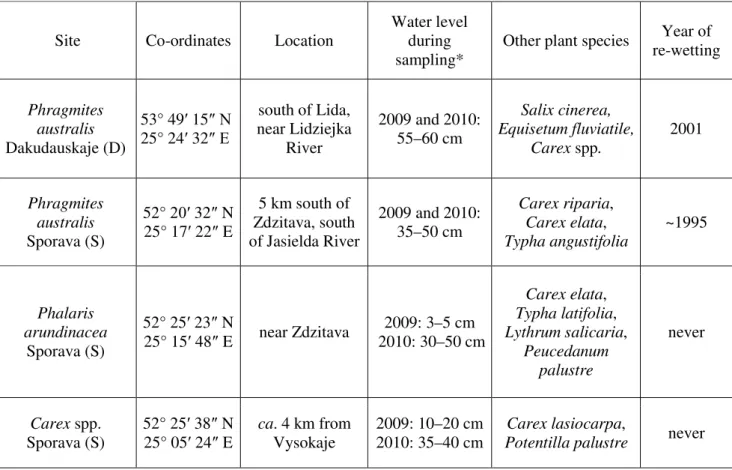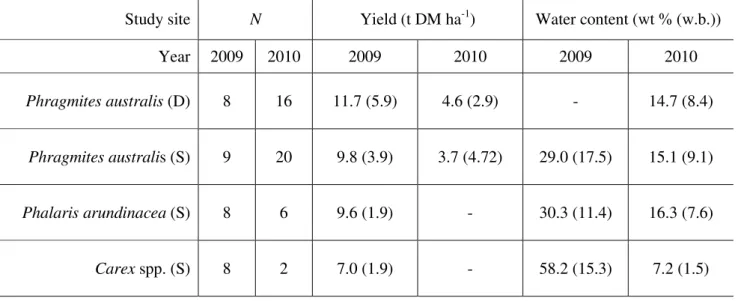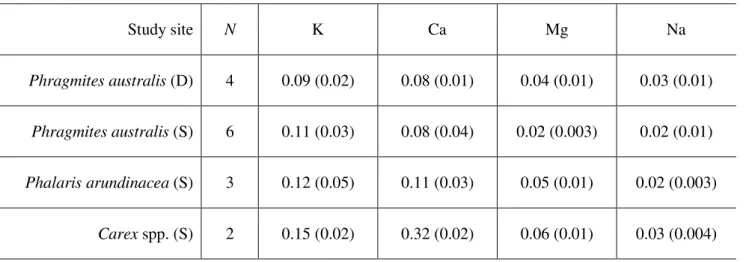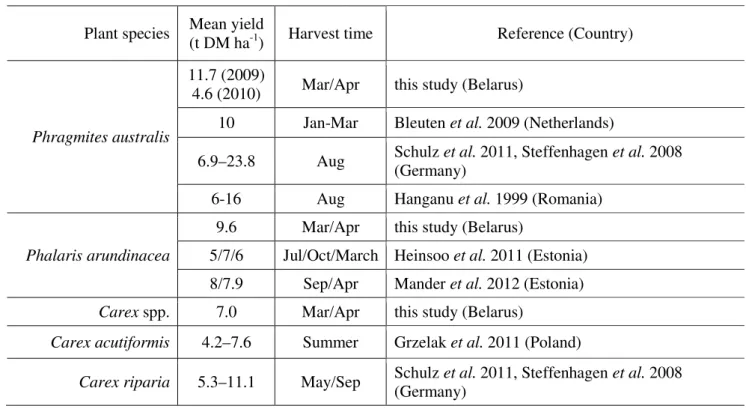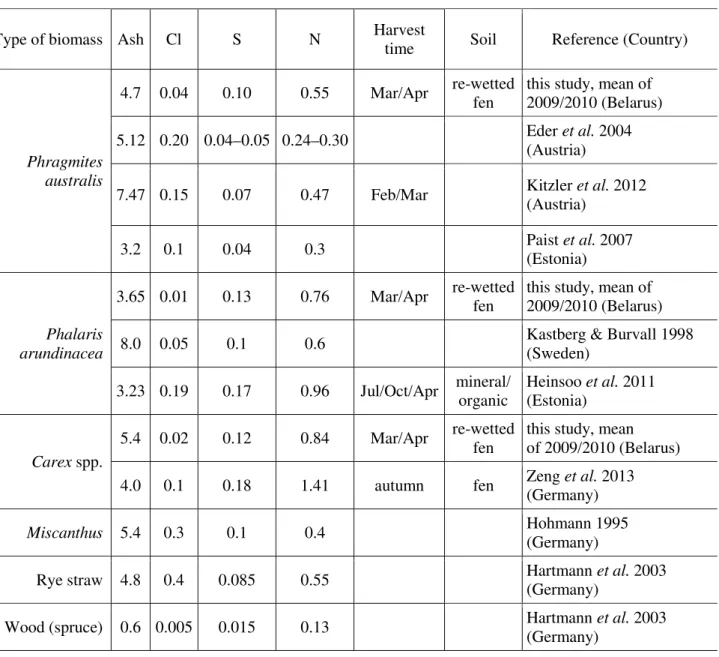Combustibility of biomass from wet fens in Belarus
and its potential as a substitute for peat in fuel briquettes
W. Wichtmann
1,2, C. Oehmke
2, S. Bärisch
1, F. Deschan
2, U. Malashevich
3and F. Tanneberger
1,21 Michael Succow Foundation for the Protection of Nature, Greifswald, Germany 2 Institute of Botany and Landscape Ecology, Greifswald University, Greifswald, Germany
3 APB-Birdlife Belarus, Minsk, Belarus
_______________________________________________________________________________________
SUMMARY
Peatland drainage has caused enormous environmental problems at global scale; in particular, ongoing greenhouse gas emissions and soil degradation. In Belarus, which is rich in peatlands and a hotspot of emissions from drained peatlands, several thousand hectares have already been re-wetted but are not used productively. Moreover, vast areas of wet (undrained) peatland that are designated for nature conservation are in need of mowing and biomass removal. Plants such as common reed (Phragmites australis), reed canary grass (Phalaris arundinacea) and sedges (Carex spp.) which frequently dominate these areas could be harvested and used as fuel, potentially as a substitute for peat. In this study we analysed the yield and combustibility of late harvests in March/April 2009 and 2010. The yields of 3.7–11.7 t DM ha-1 were within the range reported from other studies on wetland plants. Concentrations of Cl, S, N, P, C, Ca, K, Mg and Na, as well as water and ash contents, indicated similar or better combustibility when compared to other straw-like (graminaceous) plants such as Miscanthus. The full replacement of peat fuel by biomass from wet peatlands in Belarus would require an area of 680,000 ha, i.e. 'only' half of the peatland that has been drained for agriculture.
KEY WORDS: biofuel; nature conservation; reed; re-wetting; paludiculture
_______________________________________________________________________________________
INTRODUCTION
Mires formerly covered about 15 % of Belarus, extending to almost three million hectares. Approximately 1.5 million hectares have now been drained (Tanovitskaya 2011) and, as a result, the country is ranked eighth in the world for national greenhouse gas emissions from peatlands (41 Mt CO2 per year; Joosten 2009). The drained peatlands are used for agriculture (72 %), forestry (26 %) and peat extraction (2 %) (Tanovitskaya 2011). The output of 26 peat ‘factories’ is used mostly as fuel for heating and power generation, and regarded as important for domestic energy security.
The continuous CO2 emissions from peat degradation, augmented by emissions from peat fires, could be avoided by raising peatland water levels. By 2011, around 36,000 ha of peatland had been re-wetted but most of this area was not used productively (Tanneberger & Wichtmann 2011). Productive 'wet' land use (paludiculture) could provide, for example, renewable fuels to replace fossil ones, and thus generate both income and further carbon savings. It could also arrest the dense overgrowth of abandoned open fens by tall reed and shrub vegetation, which is one of the most important nature conservation problems in Belarus. Moreover,
the resumption of traditional mowing of wet fens could reinstate habitats for much of the threatened flora and fauna.
shown that 150 mm of precipitation is sufficient to reduce the Cl concentration by 75–80 % and the K concentration by 60–70 % (Hernández Allica et al. 2001). Additionally, the loss of N- and K-rich leaves (Granéli 1990, Landström et al. 1996) and the recycling of nutrients into the rhizomes (e.g. 80 % of the August K content; Granéli 1990) lowers the elemental concentrations in above-ground biomass.
Most studies on yields and combustibility of straw-like energy plants (e.g. Phalaris arundinacea, Miscanthus) have been conducted on mineral soils. Heinsoo et al. (2011) indicate that there are differences between mineral and peat soils in this context, but studies from the latter are scarce. This article provides data on potential yields and combustion characteristics of winter harvested biomass from a re-wetted peat extraction site (Dakudauskaje) and a wet abandoned peatland (at Sporava). It also assesses the potential for replacing peat fuel briquettes with biomass briquettes produced from wet peatlands in Belarus.
METHODS
Study sites
Biomass was sampled at two peatlands in Belarus (Dakudauskaje and Sporava; Figure 1). The four study sites were delineated on the basis of a field survey of dominant vegetation types suitable for biomass harvesting, which was carried out in late March and early April 2009 and March 2010 (Wichtmann & Tanneberger 2009).
The Dakudauskaje site is dominated by the common reed Phragmites australis (Table 1). Dakudauskaje is located in Hradna region, Lida district. The peatland extends to 7,811 ha, of which 3,583 ha has been excavated. Some excavated areas have already been re-wetted, and re-wetting is planned for the remainder. The water table is currently 1.2–1.5 m below the soil surface, and peat fires occur frequently. The study site is a patch of approximately 100 ha that was excavated and re-wetted about 15 years ago. As is typical for the
Table 1. Locations and characteristics of the four study sites. The Phalaris arundinacea site (Sporava) burned in 2009. Otherwise, none of the sites had been disturbed for at least five years.
Site Co-ordinates Location
Water level during sampling*
Other plant species re-wetting Year of
Phragmites australis Dakudauskaje (D)
53° 49′ 15″ N 25° 24′ 32″ E
south of Lida, near Lidziejka
River
2009 and 2010: 55–60 cm
Salix cinerea, Equisetum fluviatile,
Carex spp.
2001
Phragmites australis Sporava (S)
52° 20′ 32″ N 25° 17′ 22″ E
5 km south of Zdzitava, south of Jasielda River
2009 and 2010: 35–50 cm
Carex riparia, Carex elata, Typha angustifolia
~1995
Phalaris arundinacea
Sporava (S)
52° 25′ 23″ N
25° 15′ 48″ E near Zdzitava
2009: 3–5 cm 2010: 30–50 cm
Carex elata, Typha latifolia, Lythrum salicaria,
Peucedanum palustre
never
Carex spp. Sporava (S)
52° 25′ 38″ N 25° 05′ 24″ E
ca. 4 km from Vysokaje
2009: 10–20 cm 2010: 35–40 cm
Carex lasiocarpa,
Potentilla palustre never
* above soil surface
majority of cutover areas 5–15 years after re- wetting, large reed beds have developed. The Lida peat factory, which is located close to the peatland, has been trialling the production of mixed briquettes (peat with straw) for several years.
The three Sporava sites have vegetation dominated, respectively, by (1) common reed (Phragmites australis), (2) reed canary grass (Phalaris arundinacea) and (3) sedges (Carex spp.) (Table 1). Sporava is located in Brest region, Beriosa district. Situated in the floodplain of the Jasielda river, it is one of the largest (ca. 20,000 ha) and least modified floodplain mires in Europe. The vegetation is dominated by sedge communities and wet meadows with associated reed beds, willow thickets and agricultural grasslands. Parts of the area are used for haymaking and cattle grazing, but much of it has been abandoned during the last 20 years. Rapid and, presumably, accelerating overgrowth by bushes is currently causing loss of open mire habitat at an estimated rate of 5 % per year (Wichtmann & Tanneberger 2009). The Sporava peatland includes an extensive area of suitable breeding habitat for the Aquatic Warbler Acrocephalus paludicola (a
globally threatened songbird) and an internationally significant proportion of the Caricetum elatae plant community, both of which are in urgent need of vegetation management.
Biomass sampling and analysis
Table 2. Methods and equipment for biomass analyses.
Attributes
measured Methods Instruments
C, N, S Dry combustion according to DIN ISO 15104 (2010) and DIN ISO 15178 (2001)
Elemental analyser Vario EL III, Elementar Analysesysteme Hanau, Germany
K, Mg, Ca, Na Microwave digestion with HNO3 and H2O2 and atomic absorption spectroscopy
Microwave 1500, MLS GmbH Start, AAS ContrAA 300, Analytik Jena Germany
P
Microwave digestion with HNO3 and H2O2, and photometric measuring of
orthophosphates
UV/VIS spectral photometer Cecil CE 102. 1000 Series, Analytik Jena, Germany
Cl HNO3 extraction according to Islam et al. (1983)
Ion-selective electrode (ISE),
Monokrystaly Turnov, Czech Republic
Ash content Loss on ignition at 550 °C, DIN ISO 14775 (2010) Muffle furnace, Heraeus instrument
RESULTS
The mean yield in 2009 was highest at the
Phragmites australis (D) site (11.7 t DM ha-1) and
lowest at the Carex spp. (S) site (7.0 t DM ha-1) (Table 3). In 2010, the yields at all Phragmites sites were much lower (3.7–4.6 t DM ha-1), and representative samples could not be collected from the Phalaris arundinacea and Carex spp. sites.
The water contents of Phragmites australis and Phalaris arundinacea were similar at the two harvest dates (ca. 30 wt % in 2009 and ca. 16 wt %
in 2010). In contrast, the Carex spp. biomass was much wetter in 2009 (ca. 60 wt %) than in 2010 (7 wt %). The within-site variability was high.
Except for N concentrations, which were substantially higher at all study sites in 2010, the elemental concentrations differed only slightly between sites, plots and years (Table 4). There were almost no differences between sites in the concentrations of elements affecting ash melting (K, Ca, Mg and Na), although conspicuously higher Ca concentrations (0.32 wt % d.b. = dry biomass) were measured in Carex spp. (Table 5).
Table 3. Mean yields (in t DM ha-1)and water contents (in weight % w.b. = wet biomass) of winter harvested plant biomass from wet peatlands in Belarus. D: Dakudauskaje; S: Sporava; N: number of samples. Standard deviations are given in brackets.
Study site N Yield (t DM ha-1) Water content (wt % (w.b.))
Year 2009 2010 2009 2010 2009 2010
Phragmites australis (D) 8 16 11.7 (5.9) 4.6 (2.9) - 14.7 (8.4)
Phragmites australis (S) 9 20 9.8 (3.9) 3.7 (4.72) 29.0 (17.5) 15.1 (9.1)
Phalaris arundinacea (S) 8 6 9.6 (1.9) - 30.3 (11.4) 16.3 (7.6)
Table 4. Concentrations of ash and chemical elements in winter harvested plant biomass from wet peatlands in Belarus. Mean values and (standard deviations) are given in wt % (d.b.). D: Dakudauskaje; S: Sporava.
Study site N Ash C Cl S N P
Y
ear
2009 2010 2009 2010 2009 2010 2009 2010 2009 2010 2009 2010 2009 2010
Phragmites australis (D) 1 4 4.1 (0.5) 4.4 46.9 (0.7) 45.0 0.01 (0.02) 0.03 0.09 (0.01) 0.10 0.43 (0.07) 0.63 0.03 (0.01) 0.04
Phragmites australis (S) 1 6 4.6 (1.7) 5.7 46.6 (1.2) 44.4 0.05 (0.02) 0.05 0.09 (0.02) 0.11 0.49 (0.14) 0.65 0.04 (0.01) 0.04
Phalaris arundinacea (S) 1 3 4.3 3.0
(0.3) 46.7 46 (0.1) 0.01
0.01 (0.005) 0.13
0.12 (0.02) 0.61
0.91 (0.25) 0.06
0.07 (0.02)
Carex spp. (S) 1 2 5.3 5.6
(0.7) 47.1 45.2 (0.5) 0.01
0.03 (0.001) 0.10
0.13 (0.02) 0.72
0.95 (0.13) 0.06
0.07 (0.02)
Table 5. Concentrations of elements affecting ash melting (K, Ca, Mg and Na) in winter harvested plant biomass from wet peatlands in Belarus (2010). Mean values and (standard deviations) are given in wt % (d.b.). D: Dakudauskaje; S: Sporava.
Study site N K Ca Mg Na
Phragmites australis (D) 4 0.09 (0.02) 0.08 (0.01) 0.04 (0.01) 0.03 (0.01)
Phragmites australis (S) 6 0.11 (0.03) 0.08 (0.04) 0.02 (0.003) 0.02 (0.01)
Phalaris arundinacea (S) 3 0.12 (0.05) 0.11 (0.03) 0.05 (0.01) 0.02 (0.003)
Carex spp. (S) 2 0.15 (0.02) 0.32 (0.02) 0.06 (0.01) 0.03 (0.004)
DISCUSSION
Yields and water content
Summer yields are usually substantially higher than winter yields for the same plant species (Table 6). Seasonal losses of 18–24 % for Phalaris arundinacea on peat soils (Heinsoo et al. 2011) and of 25 % for Miscanthus (Lewandowski et al. 2003) have been reported. For Phragmites australis, assuming a mean summer yield of 6–24 t DM ha-1 and a loss of 30 %, the mean winter yield would be 4.2–16.8 t DM ha-1. While our 2009 values are in
Table 6. Mean yields of Phragmites australis, Phalaris arundinacea and Carex species on wet peat soils.
Plant species Mean yield
(t DM ha-1) Harvest time Reference (Country)
Phragmites australis
11.7 (2009)
4.6 (2010) Mar/Apr this study (Belarus)
10 Jan-Mar Bleuten et al. 2009 (Netherlands)
6.9–23.8 Aug Schulz et al. 2011, Steffenhagen et al. 2008 (Germany)
6-16 Aug Hanganu et al. 1999 (Romania)
Phalaris arundinacea
9.6 Mar/Apr this study (Belarus)
5/7/6 Jul/Oct/March Heinsoo et al. 2011 (Estonia) 8/7.9 Sep/Apr Mander et al. 2012 (Estonia)
Carex spp. 7.0 Mar/Apr this study (Belarus)
Carex acutiformis 4.2–7.6 Summer Grzelak et al. 2011 (Poland)
Carex riparia 5.3–11.1 May/Sep Schulz et al. 2011, Steffenhagen et al. 2008 (Germany)
severe frost and high water table before or at the harvest date (Table 1), which destroyed parts of the biomass and hampered sampling. Weather conditions and water levels presumably strongly affect yields in wet and re-wetted peatlands. Further factors influencing biomass yields such as site conditions (medium water tables, nutrient conditions) and genotypes of plants have not yet been investigated in Belarus.
Biomass with water contents above 20 % (w.b.) is in danger of self-ignition and decomposition by fungi and, thus, requires additional drying (Eckl 2003). The water content of winter harvested biomass is lower than that of summer harvested biomass (Hadders & Olsson 1997, Heinsoo et al. 2011). Values measured in this study were in the range 29–58 % (w.b.) in 2009 and 7–16 % (w.b.) in 2010 (Table 3). Therefore, only the 2009 biomass would require substantial additional drying and the 2010 biomass could be further processed without drying. This problem could be avoided by choosing more favourable dates for harvesting. Possible reasons for the high 2009 values are wet weather conditions preceding sampling, and cutting of moist plant parts close to the soil/water surface. In 2010, cutting was high due to high water levels. To reduce the water content of biomass from wet peatlands, cutting should be high (above the water level, usually by 10–30 cm, Haslam 2010). After harvesting, the biomass should be processed
immediately and any loose material stored in a dry place (Wichtmann & Tanneberger 2009). In wet peatlands, it is not feasible to conduct drying on the ground, as is usual in grassland management and haymaking. Because traditional drying in hay stacks is very labour-intensive, it is advisable to use a well-aerated piece of ground outwith the peatland for any drying that is needed.
Combustibility
Table 7. Concentrations of ash, Cl, S, and N of peatland plants in comparison to other biofuels (wt % (d.b.)).
Type of biomass Ash Cl S N Harvest
time Soil Reference (Country)
Phragmites australis
4.7 0.04 0.10 0.55 Mar/Apr re-wetted fen this study, mean of 2009/2010 (Belarus)
5.12 0.20 0.04–0.05 0.24–0.30 Eder et al. 2004 (Austria)
7.47 0.15 0.07 0.47 Feb/Mar Kitzler et al. 2012 (Austria)
3.2 0.1 0.04 0.3 Paist et al. 2007 (Estonia)
Phalaris arundinacea
3.65 0.01 0.13 0.76 Mar/Apr re-wetted fen
this study, mean of 2009/2010 (Belarus)
8.0 0.05 0.1 0.6 Kastberg & Burvall 1998 (Sweden)
3.23 0.19 0.17 0.96 Jul/Oct/Apr mineral/ organic Heinsoo et al. 2011 (Estonia)
Carex spp.
5.4 0.02 0.12 0.84 Mar/Apr re-wetted fen
this study, mean of 2009/2010 (Belarus)
4.0 0.1 0.18 1.41 autumn fen Zeng et al. 2013 (Germany)
Miscanthus 5.4 0.3 0.1 0.4 Hohmann 1995 (Germany)
Rye straw 4.8 0.4 0.085 0.55 Hartmann et al. 2003 (Germany)
Wood (spruce) 0.6 0.005 0.015 0.13 Hartmann et al. 2003 (Germany)
concentrations of elements that may cause low ash melting temperatures (K, Na, Ca and Mg) were very low (0.02–0.15 %) except for Ca in Carex spp. biomass (0.32 %). Concentrations in straw were much higher (K 1.68 %, Na 0.05 %, Ca 0.36 % and Mg 0.06 %; Hartmann et al. 2003, Obernberger et al. 2006). We conclude that late (March/April) harvesting ensures good combustibility by allowing substantial loss of critical elements through precipitation-induced leaching. However, the use of
Phalaris, Phragmites and Carex spp. as biofuels
requires special techniques. Grate or fluidised bed combustion would be suitable because it can accommodate higher ash contents. The very low Cl concentrations and moderate S and N concentrations should not lead to serious emissions problems.
Potential of biomass
Irregular mowing of at least 1,000 ha of Phalaris vegetation and 6,000 ha of Carex spp. vegetation is required to maintain the protected area at Sporava. Assuming a (conservative) mean yield of 5 t DM ha-1, 7,000 t of biomass could be harvested annually from an area of 1,400 ha. However, harvesting every part of this area once in five years (e.g. one-fifth of the total area per year) will presumably be sufficient to maintain the desired Aquatic Warbler habitat conditions.
At Dakudauskaje, about 300 ha of Phragmites is currently available for harvesting. In an ongoing co-operative project with the Lida peat briquette factory, the proportion of peat in the briquettes is being gradually reduced in favour of above-ground biomass harvested from wet peatlands, and the combustibility of the mixed briquettes is being investigated. Since reedbeds are advancing onto areas where peat extraction has recently ceased, biomass may increasingly be used as a diluent for peat and eventually replace it.
More generally, there is great potential in Belarus for the replacement of peat briquettes with biomass from wet peatlands. To substitute the total quantity of fuel peat extracted annually in Belarus (recently some 3.5 million tonnes, N. Bambalov and V. Rakovich pers. comm.), 680,000 ha of wet peatland must be harvested (assuming a mean yield of 5 t DM ha-1 and a calorific value of around 17 MJ kg-1). This is approximately 23 % of the total peatland area. According to Kozulin (2011), another 260,000 ha of (mainly) extracted peatland and 250,000 ha of agriculturally degraded peatland may be re-wetted in the future.
CONCLUSIONS
1. The potential yield and combustibility of biomass from wet and re-wetted peatlands are such that it is a suitable substitute for other fuels.
2. To fully replace the fuel peat that is currently extracted in Belarus with biomass from wet peatlands, around 680,000 ha of paludiculture would be required.
3. This is approximately 50 % of the peatland area that has already been drained for agriculture in Belarus.
4. Implementing paludiculture at this scale would substantially reduce the country’s greenhouse gas emissions and establish a sustainable use of peatlands.
ACKNOWLEDGEMENTS
We gratefully acknowledge funding from the IKI Initiative of the German Ministry of Environment, Nature Conservation and Nuclear Safety and the EU-Aid Programme (DC ENV/2010/220-473). We thank A. Kozulin (Belarussian Academy of Sciences) and V. Fenchuk (APB) for help with identification of the sampling sites; and N.Lezhinskaya, P. Kharitonov, A. Thiele, M. Minke (all APB), V. Protasevich (Sporovski zakaznik) and V. Zhukovich (Zditovo) for practical support during fieldwork. This article is based on a presentation delivered at the international conference on the utilisation of emergent wetland plants “Reed as a Renewable Resource”, held on 14–16 February 2013 at the University of Greifswald, Germany.
REFERENCES
Bambalov, N.N. & Rakovich, V.A. (2005) Rol bolot v biosfere (Role of Mires in the Biosphere). “The Belarus Science”, Minsk, 285 pp. (in Russian). Barz, M., Tanneberger, F. & Wichtmann, W. (2011)
Sustainable production of Common Reed as an energy source from wet peatlands. In: Proceedings of the 4th International Conference on Sustainable Energy and Environment (SEE 2011): A Paradigm Shift to Low Carbon Society, Centara Grand & Bangkok Convention Centre at Central World, Bangkok, Thailand, 2012, ISBN 978-616-202-575-4, 780–787.
Bleuten, W., Borren, W., Kleinveld, E., Ooomes L.E. & Timmermann, T. (2009) Water and nutrient balances of the experimental site Mariapolder, the Netherlands. In: Barendregt, A., Whigham, D.F., Baldwin, A.H. & Whigham, D. (eds.) Tidal Freshwater Wetlands, Backhuys Publishers, Leiden, The Netherlands, 197–206. DIN ISO 14775 (2010) Solid biofuels –
Determination of ash content. Beuth Verlag, Berlin.
DIN ISO 15104 (2010) Solid biofuels – Determination of carbon, hydrogen and nitrogen – Instrumental methods. Beuth Verlag, Berlin. DIN ISO 15178 (2001) Soil quality - Determination
of total sulfur by dry combustion. Beuth Verlag, Berlin.
Eckl, J. (2003) Der Heuselbstentzündung vorbeugen (Preventing self-ignition of hay). Fachhoch-schule Weihenstephan (in German). Online at:
http://www.proteinmarkt.de/uploads/media/heuse lbstentzndung2003.pdf, accessed 29 Dec 2013. Eder, G., Haslinger, W. & Wörgetter, M. (2004)
Schilfpellets (Report on the Energetic Use of Reed). Im Auftrag des Amtes der Burgen-ländischen Landesregierung, Abt. 9, Wasser- und Abfallwirtschaft, 53 pp. (in German).
Granéli, W. (1989) Influence of standing litter on shoot production in reed, Phragmites australis (Cav.) Trin. ex Steudel. Aquatic Botany Amsterdam, 35, 99–109.
Granéli, W. (1990) Standing crop and mineral content of Reed, Phragmites australis (Cav.) Trin. ex Steudel, in Sweden - Management of reed stands to maximize harvestable biomass. Folia Geobotanica, 25, 291–302.
Grzelak, M., Waliszewska, B., Sieradzka, A. & Speak-Dzwigała, A. (2011) Ecological meadow communities with participation of species from sedge (Carex) family. Journal of Research and Applications in Agricultural Engineering, 56, 122–126.
Hadders, G. & Olsson, R. (1997) Harvest of grass for combustion in late summer and in spring. Biomass quality for power production. Biomass and Bioenergy, 12, 171–175.
Hanganu, J., Mihail, G. & Coops, H. (1999) Responses of ecotypes of Phragmites australis to increased seawater influence: a field study in the Danube Delta, Romania. Aquatic Botany, 64, 351–358.
Hartmann, H., Thuneke, K., Höldrich, A. & Rossmann, P. (2003) Handbuch Bioenergie-Kleinanlagen (Manual of Small Bioenergy
Plants). Tangram documents, Bentwisch,
Fachagentur Nachwachsende Rohstoffe (FNR), Gülzow, 184 pp. (in German).
Haslam, S.M. (2003) Understanding Wetlands. Fen, Bog and Marsh. Taylor & Francis, London and new York, 312 pp.
Haslam, S.M. (2010) A Book of Reed: (Phragmites australis (Cav.) Trin. ex Steudel, Formerly Phragmites communis Trin.). Forrest Text, Cardigan, GB, 254 pp.
Heinsoo, K., Hein, K., Melts, I. Holm, B. & Ivask, M. (2011) Reed canary grass yield and fuel quality in Estonian farmers’ fields. Biomass and Bioenergy, 35, 617–625.
Hernández Allica, J., Mitre, A.J., González Bustamante, J.A., Itoiz, C., Blanco, F., Alkorta, I. & Garbisu, C. (2001) Straw quality for its combustion in a straw-fired power plant. Biomass and Bioenergy, 21, 249–258.
Hohmann, T. (1995) Energetische Nutzung von
Miscanthus (Energetic Use of Miscanthus).
Schriftenreihe Nachwachsende Rohstoffe, FNR, Band 4, Landwirtschaftsverlag Münster, 143– 158 (in German).
Islam, A.K.M.S., Kerven, G.L. & Asher, C.J. (1983)
Chlorid determination in plant tissue using a solid state chlorid ion specific electrode. Communications in Soil Science and Plant Analysis, 14(7), 645–653.
Joosten, H. (2009) The Global Peatland CO2
Picture. Peatland Status and Drainage Related Emissions in All Countries of the World (Updated August 2010). Wetlands International, Ede, 10 pp. Online at: http://tinyurl.com/yaqn5ya
accessed 29 Dec 2013.
Kastberg, S. & Burvall, J. (1998) Perennial rhizomatous grass – Reed canary grass as an upgraded bio-fuel: experiences from combustion tests in Sweden. In: El Bassam, N., Behl, R.K. & Prochnow, B. (eds.) Sustainable Agriculture for Food, Energy and Industry, James & James Ltd., London, 932–937.
Kitzler, H., Pfeifer, Ch. & Hofbauer, H. (2012) Combustion of reeds in a 3 MW district heating plant. International Journal of Environmental Science and Development, 3, 407–411.
Kozulin, A. (2011) Rewetting of peatland. In: Tanneberger, F. & Wichtmann, W. (eds.) Carbon Credits from Peatland Rewetting. Climate - Biodiversity - Land Use. Schweizerbart Science Publishers, Stuttgart, 9–12.
Landström, S., Lomakka, L. & Andersson, S. (1996) Harvest in spring improves yield and quality of reed canary grass as a bioenergy crop. Biomass and Bioenergy, 11, 333–341.
Lewandowski, I., Scurlock, J.M.O., Lindvall, E. & Christou, M. (2003) The development and current status of perennial rhizomatous grasses as energy crops in the US and Europe. Biomass and Bioenergy, 25, 335–361.
Mander, Ü., Järveoja, J., Maddison, M., Soosaar, K., Aavola, R., Ostonen, I. & Salm, J.-O. (2012) Reed canary grass cultivation mitigates greenhouse gas emissions from abandoned peat extraction areas. Global Change Biology Bioenergy, 4(4), 462–474.
Obernberger, I., Brunner, Th. & Bärnthaler, G. (2006) Chemical properties of solid biofuels— significance and impact. Biomass and Bioenergy, 30(11), 973–982.
Paist, A., Kask, Ü. & Kask, L. (2007) Composition of reed mineral matter and its behavior at combustion. In: From Research to Market Deployment: Proceedings of the 15th European
BiomassConference and Exhibition (Berlin,7–11
May 2007). ETA-Florence/WIP-Munich, 1666– 1669.
Hydrobiologia, 674, 25–40.
Steffenhagen, P., Timmermann, T., Schulz, K. & Zerbe, S. (2008) Biomasseproduktion sowie Kohlenstoff- und Nährstoffspeicherung durch Sumpfpflanzen (Helophyten) und Wasserpflanzen (Hydrophyten) (Biomass Production and Carbon and Nutrient Storage of Helophytes and Hydrophytes). Berichte des Leibnitz-Instituts für Gewässerökologie und Binnenfischerei, 26, 145– 154 (in German).
Tanneberger, F. & Wichtmann, W. (2011) Carbon Credits from Peatland Rewetting. Climate - Biodiversity - Land Use. Schweizerbart Science Publishers, Stuttgart, 223 pp.
Tanovitskaya, N. (2011) Use of peatlands and peat. In: Tanneberger, F. & Wichtmann, W. (eds.) Carbon Credits from Peatland Rewetting. Climate - Biodiversity - Land Use. Schweizerbart Science Publishers, Stuttgart, 7–9.
Wichtmann, W. & Schulz, J. (2011) Biomass for energy. In: Tanneberger, F. & Wichtmann, W. (eds.) Carbon Credits from Peatland Rewetting. Climate - Biodiversity - Land Use. Schweizerbart
Science Publishers, Stuttgart, 115–128
Wichtmann, W. & Tanneberger, F. (2009) Feasibility of the Use of Biomass from Re-wetted Peatlands for Climate and Biodiversity Protection in Belarus. Report to the project ‘Restoring peatlands and applying concepts for sustainable management in Belarus – climate change mitigation with economic and biodiversity benefits’, Michael Succow Stiftung zum Schutz der Natur, Greifswald, 112 pp. Zeng, T., Brosowski, A., Braumann F., Pollex, A. &
Lenz, V. (2013) Verwertungskonzepte zur energetischen Nutzung von geeignetem Grünlandaufwuchs im Naturpark Drömling (Utilisation concepts for the energetic use of suitable grassland biomass in Drömling Nature Park). In: Nelles, M. (ed.) Tagungsband zum 7. Rostocker Bioenergieforum, 20/21 June 2013,
Rostock, Series Umweltingenieurwesen, 36, 73–
84 (in German). ISBN 978-3-86009-207-1.
Submitted 30 Oct 2013, revision 24 Dec 2013 Editor: Olivia Bragg
_______________________________________________________________________________________
Author for correspondence:
Dr. Wendelin Wichtmann, Michael Succow Foundation for the Protection of Nature, Ellernholzstrasse 1/3, 17489 Greifswald, Germany.
